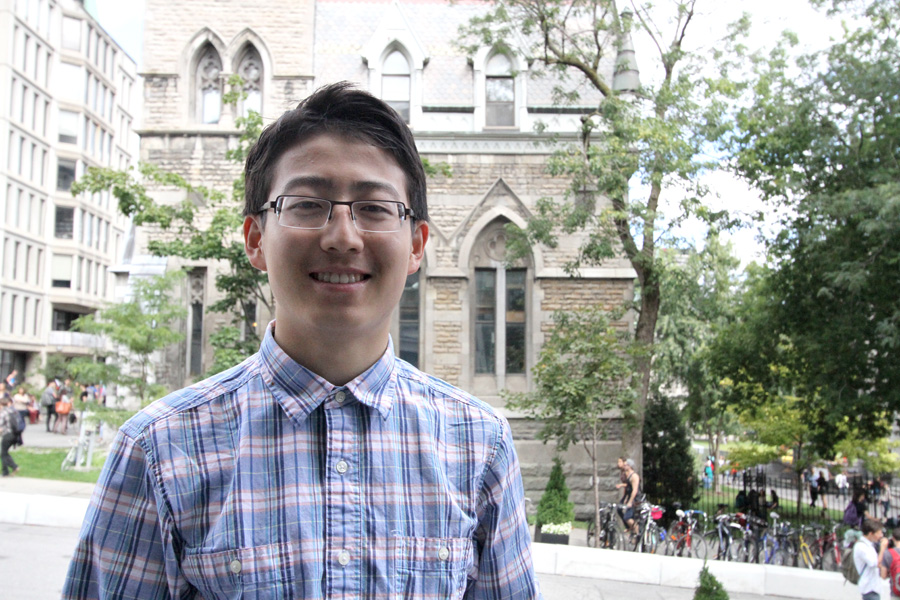Getting published as an undergraduate student is a honourable achievement—one of which U3 quantitative biology student Blair Jia received this August. This summer Jia designed a fabrication protocol to improve the imaging chamber used in Convex LensInduced Confinement (CLIC) microscopy under the supervision of Assistant Professor Sabrina Leslie from the Department of Physics.
Jia focused his efforts for about seven months on designing an alternative fabric to replace the ‘tape’ used by the lab in their CLIC microscopy. The device relies on a simple principle where the sample of fluid containing molecules under observation is compressed into a well-defined nanoscale gap using a plano-convex lens. Chambers made of glass coverslips sandwich a piece of tape which has a shape cut out of it to form the chamber.
The lens deforms the chamber as it is brought down over it, creating a unique and diverse height profile for the confined molecules. Currently, the lab uses this technique to study how transcription factors—molecules that control gene expression—search and read the genome.
While the tape allowed the molecules to be viewed clearly, it was stored on wax paper backings, which introduced a lot of bumps in the chamber. These caused variations in height within the chamber which were problematic for the laboratory’s research.
 “Because my lab is mostly biophysicists they weren’t very experienced at fabrication [the process of designing and constructing devices],” recalls Jia. “So when I initially approached this problem, I consulted a bioengineering professor, David Juncker […] He does is that he works with a material known as Polydimethylsiloxane (PDMS). With this material he makes lots of microfluidic devices, and he fabricates them on a micro and a nano scale.”
“Because my lab is mostly biophysicists they weren’t very experienced at fabrication [the process of designing and constructing devices],” recalls Jia. “So when I initially approached this problem, I consulted a bioengineering professor, David Juncker […] He does is that he works with a material known as Polydimethylsiloxane (PDMS). With this material he makes lots of microfluidic devices, and he fabricates them on a micro and a nano scale.”
Using PDMS, Jia was able to design a protocol to produce a film that was only a few microns thick. He spin-casted thin PDMS membranes and treated their surface before bonding the membrane to a glass coverslip to form the improved chambers.
Although Jia did not enter the lab with the intention of getting published, it was a rewarding outcome after seven months of hard work.
“I definitely tasted the bitterness of scientific research. I can’t say I was a victim, but I definitely tasted it,” said Jia, “When I was going over my concept and my protocol, on paper it was super simple […] but in between the steps, there are these subtle difficulties that took a long time to overcome. An example would be when I was trying to lift a film off a wafer. The film was like 30 microns, and if I just tried to peel it off with tweezers, it ripped.”
While Jia initially came to McGill under the impression that he wanted to go to medical school, his experience in research has inspired him to consider graduate school in biomedical engineering.
“Every day I walk into the lab, and I feel humbled and wow-ed by the many amazing people that I work with […] the people at my lab are phenomenal, and I have really enjoyed my experience here thus far.”
Favourite lab task:
“Microscopy—that’s been really cool. I also thought the microfabrication techniques were really cool. I actually got to work a little bit in the McGill nanofabrication lab!”
Least favourite task:
“Something I really hate is drilling coverslips, but I’m the only one who can do it well, so that job is always delegated to me. What this means is that when we load the cells, the top coverslip has to have holes. To do that, we use a dental tool and we spray sand through a nozzle, which gently etches away holes in the coverslip. This actually takes quite a bit of time and it’s not very hard. We crack these [coverslips] all the time though, so I have to make like fifty of them each time, and that’s not something I’m very fond of.”
Advice for students applying to a lab:
“I think it’s good to enter research if you’re set to learn something new. At McGill there are all these world leading researchers, who are top notch in their fields, and I think the right mindset is to go into the lab and say, “Wow, I’m going to be working with Canada’s premier oncologist, I’m probably going to learn some really frontier science.”
I think a lot of students especially in life sciences are motivated to go into research because a lot of people tell them to, for reasons like ‘it’s great for med school applications, or it looks good on your resume.’ I would say go into research if you are looking to learn something first-hand with an expert in the field. I think it really helps. There is nowhere else you can go where people are so open to accepting students than professors.”
If you could be a mad scientist, what would you do in your lab?
“People take different molds and they cultivate different strains and mutate them to see which ones produce a specific antibiotic to ward off bacteria. I was wondering if you could cultivate cancer cells, because they mutate the fastest, to see what kind of cells actually survive an infection the best. ”
Favourite ice cream flavour:
“What’s my favourite ice cream flavour? I actually don’t eat much ice cream. On a dairy related note, I really like cheese. I can tell you what my favourite cheese is: I like Oka cheese.”








